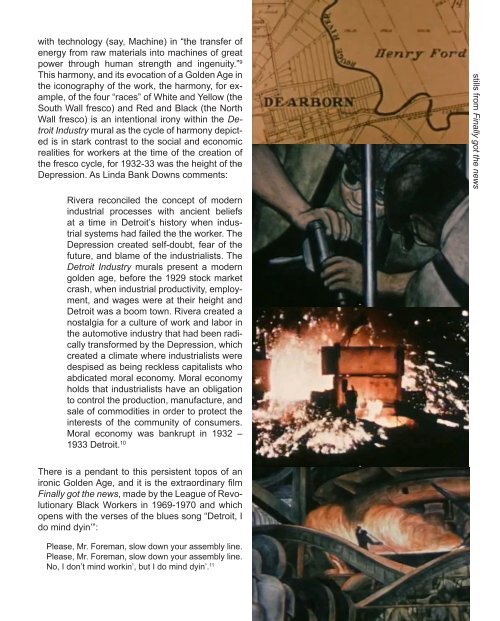Detroit Research Volume 1
You also want an ePaper? Increase the reach of your titles
YUMPU automatically turns print PDFs into web optimized ePapers that Google loves.
122<br />
with technology (say, Machine) in “the transfer of<br />
energy from raw materials into machines of great<br />
power through human strength and ingenuity.” 9<br />
This harmony, and its evocation of a Golden Age in<br />
the iconography of the work, the harmony, for example,<br />
of the four “races” of White and Yellow (the<br />
South Wall fresco) and Red and Black (the North<br />
Wall fresco) is an intentional irony within the <strong>Detroit</strong><br />
Industry mural as the cycle of harmony depicted<br />
is in stark contrast to the social and economic<br />
realities for workers at the time of the creation of<br />
the fresco cycle, for 1932-33 was the height of the<br />
Depression. As Linda Bank Downs comments:<br />
Rivera reconciled the concept of modern<br />
industrial processes with ancient beliefs<br />
at a time in <strong>Detroit</strong>’s history when industrial<br />
systems had failed the the worker. The<br />
Depression created self-doubt, fear of the<br />
future, and blame of the industrialists. The<br />
<strong>Detroit</strong> Industry murals present a modern<br />
golden age, before the 1929 stock market<br />
crash, when industrial productivity, employment,<br />
and wages were at their height and<br />
<strong>Detroit</strong> was a boom town. Rivera created a<br />
nostalgia for a culture of work and labor in<br />
the automotive industry that had been radically<br />
transformed by the Depression, which<br />
created a climate where industrialists were<br />
despised as being reckless capitalists who<br />
abdicated moral economy. Moral economy<br />
holds that industrialists have an obligation<br />
to control the production, manufacture, and<br />
sale of commodities in order to protect the<br />
interests of the community of consumers.<br />
Moral economy was bankrupt in 1932 –<br />
1933 <strong>Detroit</strong>. 10<br />
stills from Finally got the news<br />
There is a pendant to this persistent topos of an<br />
ironic Golden Age, and it is the extraordinary film<br />
Finally got the news, made by the League of Revolutionary<br />
Black Workers in 1969-1970 and which<br />
opens with the verses of the blues song “<strong>Detroit</strong>, I<br />
do mind dyin’”:<br />
Please, Mr. Foreman, slow down your assembly line.<br />
Please, Mr. Foreman, slow down your assembly line.<br />
No, I don’t mind workin’, but I do mind dyin’. 11





